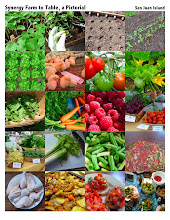 Concentrated chicken stock. Simmered once more after pouring through a sieve. I save the beautiful fat on top.
Concentrated chicken stock. Simmered once more after pouring through a sieve. I save the beautiful fat on top.
(or two if you have a big enough pot and have been saving them in your freezer)
This is more of a testimony than a recipe, on purpose.
There are endless ways to make stock. Some include onions, celery, herbs. Others instruct you to skim constantly. A recipe might tell you to simmer for no less than three hours, others say to simmer twice. I find that making chicken stock is a forgiving task. Sometimes I skim every fifteen minutes. Other times, I have forgotten to skim until the very end. It is something I put on the stove and walk away from. While it simmers, I putter around elsewhere, carefree.
Most of the time with chickens as flavorful as Synergy's I don't add anything to the pot besides the carcass, water to cover by a couple inches, and some shakes of salt and pepper. If I have half an onion or some "seconds" carrots, I'll throw those in. But I never add herbs or garlic or celery, since I don't know what I'll use the stock for ultimately and maybe I won't want those flavors.
High heat is initially necessary to bring your big pot of water and carcass to a boil, but then turn it down and find a gently simmering heat. Leave it uncovered, and skim occasionally. If the water level gets low, add some water, but try and avoid that problem by finding the gentle simmer point. Then three hours later or so, pour the stock through a large sieve and discard the solids. Chill stock, uncovered, until cool, then cover. Refrigerate or freeze. Discard the solidified fat before using stock, or better yet, save it for some future use.
To save space in your freezer, concentrate your stock by simmering it down after pouring it through a sieve.









